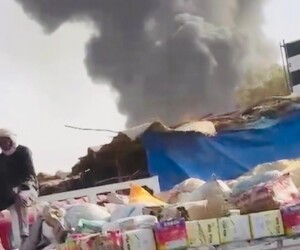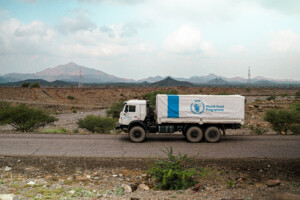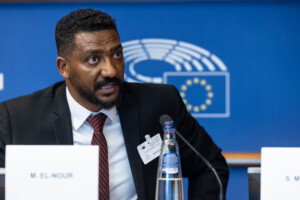Sudanese think-tank releases online documentary on violent extremism
Within the framework of its Initiative for Countering Violent Extremism, the Sudan Democracy First Group (SDFG) issued the short documentary Getting Out of the Maze, a Sudanese Vision of Violent Extremism on social media.
The SDFG seeks to break the stalemate of terrorism in Sudan, the region and the world, the Kampala-based think-tank said in a press statement on Thursday.
With the documentary, the group aims “to reflect on the public debate on the issue of violent extremism”. It presents the views of a number of Sudanese intellectuals and experts on the extent of the spread of the phenomenon in Sudan.
 Cover photo of SDFG report 'Towards a Sudanese Humanitarian Vision on Violent Extremism'
Cover photo of SDFG report 'Towards a Sudanese Humanitarian Vision on Violent Extremism'
Within the framework of its Initiative for Countering Violent Extremism, the Sudan Democracy First Group (SDFG) issued the short documentary Getting Out of the Maze, a Sudanese Vision of Violent Extremism on social media.
The SDFG seeks to break the stalemate of terrorism in Sudan, the region and the world, the Kampala-based think-tank said in a press statement on Thursday.
With the documentary, the group aims “to reflect on the public debate on the issue of violent extremism”. It presents the views of a number of Sudanese intellectuals and experts on the extent of the spread of the phenomenon in Sudan.
“Particular attention is drawn to the problems related to education, which contribute to the dissemination of specific radical ideas and views of the Islamic religion in particular,” SDFG states.
“In addition, it addresses the effects of state repression suffered by the youths through the suppression of their talents and the lack of promotion of their aesthetic senses, which leads them to directing their energies elsewhere, including falling into the trap of violent extremism and embracing extremist and violent ideas.”
The film addresses the systematic violence against women as well.
‘Terrorist ideas’
The SDFG launched the Sudanese Initiative for Countering Violent Extremism in 2017 “to draw attention to the roots and dangers of the increasing prevalence of religious extremism, the adoption of terrorist ideas in the Sudanese society, and the means to address it in local and regional contexts”.
The think-tank plans “to conduct gap analyses, researches and studies on this phenomenon, in the hope to eventually present strategies with alternative narratives to counter violent terrorism”. For this reason a Consultative Advisory Panel has been established, bringing together Sudanese and non-Sudanese experts from different schools of thoughts.
In addition, the project published its first publication, Towards a Sudanese Humanitarian Vision on Violent Extremism in April this year. The research report provides an overview of violent extremism in the world and “manifestations of extremism in the internal and external policies of Sudan”.
‘Strengthening resilience’
The the UN Development Programme in Sudan (UNDP) and the Sudan National Commission for Counter-Terrorism (SNCCT) agreed in 2016 to cooperate on strengthening the stability and resilience of citizens who could potentially be radicalised and mobilised to join violent extremists groups, including ‘at-risk’ urban and rural youth.
In May 2017, the organisations signed a Memorandum of Understanding concerning the Prevention of Violent Extremism. They announced their intention to address at-risk youth and vulnerable people who may be affected by extremism, and to build national, state, and civil society’s capacities to prevent and address violent extremism in Sudan.
In 2013, a student of the private University of Medical Sciences in Khartoum left to Mali to join Boko Haram. Two years later, dozens of Sudanese students and university graduates left their country to join the ranks of IS in Syria and Libya. In December that year, the NISS announced that was in control of “all IS recruiting cells” in Sudan.
The Sudanese Minister of Guidance and Endowments reported in August 2016 that 137 Sudanese had joined IS groups in Syria, Libya, and West Africa. He said that a number of them “had died in combat in Syria and Libya”.











 and then
and then